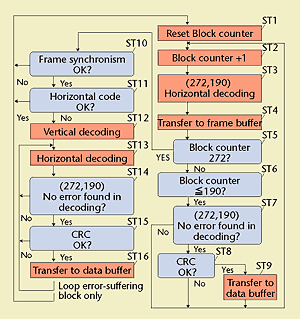FM Multiplex Broadcasting (DARC) Related Patent
Patent No.2725924 (Japanese Patent Publication No. Hei 5-145500)
"FM Multiplex Broadcasting Signal Decoding Schemes and
FM Multiplex Broadcasting Receivers"
(Patent No.5432800(U.S.), Patent No.540007 (U.K.), Patent No.540007 (Germany),
Patent No.540007 (France), Patent No.540007 (Sweden))
| Following on from the previous issue of Broadcast Technology,
this article introduces patents related to FM Multiplexed Broadcasting.
These patents are related to decoding schemes and receivers suitable
for FM multiplexed broadcasting mobile reception. Presently in Japan,
besides the broadcasting by NHK and commercial broadcasters of news,
weather forecasts, and program-related information, the VICS Center
is transmits textual and map data for car navigation systems. In
the case of mobile reception systems, phasing errors produce error-suffering
blocks in areas with generally good reception conditions, and blocks
with fewer errors in locations with extremely poor reception. In
either case, this patented decoding scheme can be used to provide
an FM multiplexed broadcasting signal decoding system for prompt
and error-free reception. |
This patent is related to
a decoding system and receiver suitable for FM multiplex broadcasting
mobile reception. In a mobile reception system, there are blocks
that suffer many errors even under the best of conditions, due to
phasing errors, and also blocks where few errors occur even under
extremely poor conditions. The decoding scheme proposed by this
patent can provide FM multiplex broadcasting signal decoding that
ensures prompt and accurate reception in either type of circumstance.
An FM multiplex broadcasting receiver structure that uses this decoding
scheme is illustrated in Figure 1, and the corresponding flowchart
in Figure 2.
The establishment of frame synchronism is determined by whether
a change in the block ID code corresponds to the block counter value.
In cases where good conditions exist and frame synchronism is established,
this patent system can almost completely eliminate uncorrected errors
that remain after the correction process, by securing the best performance
from the original product code.
There remains the possibility that frame synchronism will not be
established when there is an extremely large number of errors. Even
in such cases, however, this patent system is capable of securing
a certain level of performance by switching to horizontal-only decoding,
using phasing error characteristics. Additionally, when it is necessary
to obtain information immediately, such as when starting the power
supply, instant data display is possible by horizontal-only decoding.
|
 |
 |
| Figure 1 |
 |
| Figure 2 |
|
|


